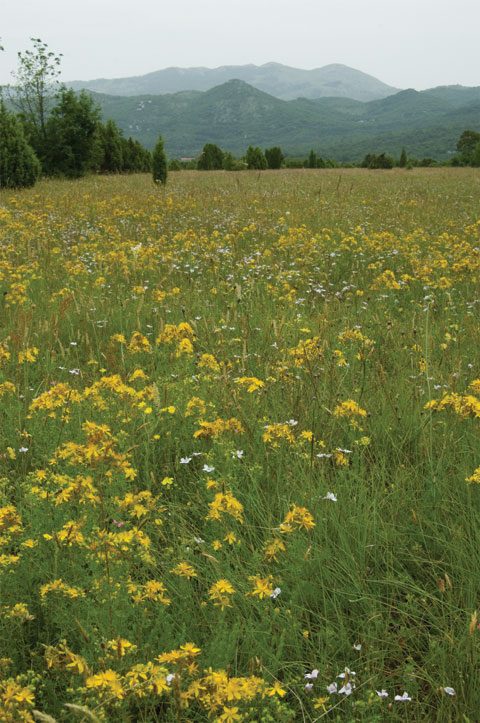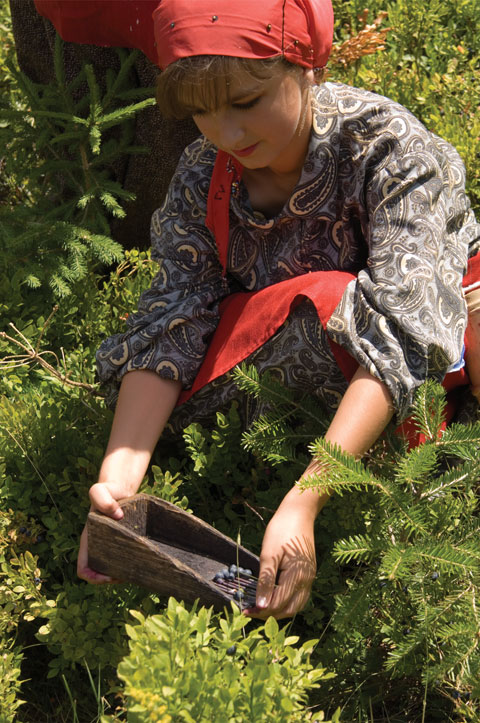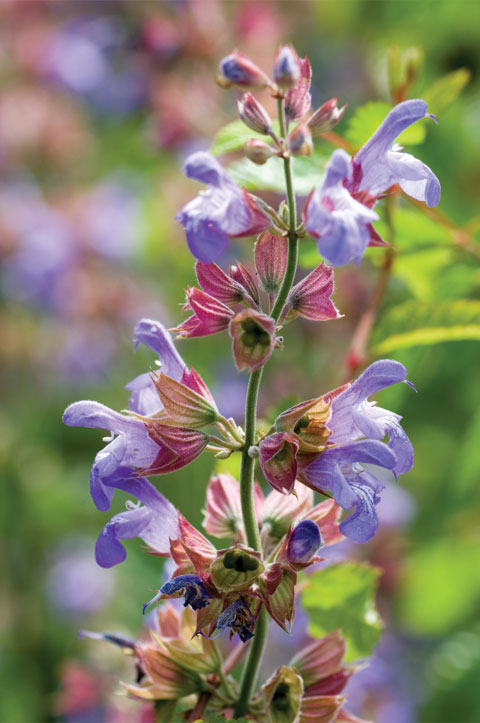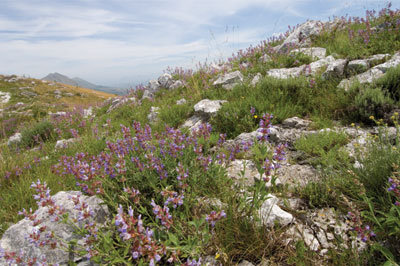Issue: 72 Page: 48-54
Medicinal Plants of Montenegro
by Steven Foster
HerbalGram. 2006; 72:48-54 American Botanical Council
Medicinal Plants of Montenegro
When I arrived in the capital of Podgorica (pronounced pod-gor-EE-za), on
May 22, 2006, thousands of red Montenegrin flags adorned with the double-headed
eagle flew from balconies, cars, and in the hands of people in the streets.
The day before, by popular vote under the watchful eye of European Union observers,
Montenegrins voted to secede from the Union of Serbia-Montenegro, also known
as the Federation of Yugoslav Republics. After nearly a century, Montenegro
is once again an independent democratic country. Europe’s newest independent
country is small in size, big in heart, with a diverse and spectacular natural
beauty rivaled by few countries of comparable size. In 1991 the Montenegrin
Assembly was the first state entity to declare itself an “ecological
state.”
Ask most Americans where Montenegro is and they may respond with a question—
“An island in the Caribbean?” No. The Italian moniker “monte
negro” (black mountains) was bestowed by passing seafarers along the
Adriatic Coast, due to the dark forests that once covered the Dinaric Alps
as seen from the Adriatic. The name Montenegro, or Crna Gora
as it is known in the local Serbian dialect, has stuck for more than 500 years.
Montenegro is a tiny country, barely the size of Connecticut with a population
of fewer than 700,000 souls. It lies on the mid-Adriatic coast, with Albania
to the South, Croatia and Bosnia and Herzegovina to the north, and Serbia
and Kosovo on its eastern borders.
 |
Mountain field of St. John’s
wort Hypericum perforatum. Photo ©2006 stevenfoster.com |
Montenegro has always existed on the periphery of attention. For centuries
larger neighbors overshadowed this country, one of the oldest in the world.
Post Neolithic settlement began in the 6th century BCE with the establishment
of Illyrian coastal towns. Fifty miles inland on the Zeta Plain, the ruins
of the ancient Roman outpost of Doclea (Dukllja) are minutes from downtown
Podgorica, the modern capital. The Romans established Doclea in the first
decade of the first century as an ancient caravan route once linking Albania
and Croatian cities at the confluence of the Morace and Zeta rivers. Following
the decline of the Roman Empire, Avars and Huns filtered into the region under
the nominal rule of Constantinople (present day Istanbul), the capital of
the Byzantine Empire. By the seventh century, Slavs from the Baltics and Poland
made their way to the Adriatic, and the Slavic state of Zeta emerged.1
Zeta, which means “the harvesters,” recognizes the long history
of wild harvest of foods such as pomegranates and figs along the coast, plus
medicinal plants, aromatic herbs, and wild mushrooms in the spectacular mountains
of modern Montenegro.2
The flora of Montenegro is one of the most diverse of any comparable-sized
temperate or subtropical region in the world. Montenegro is located in the
southwest part of the Balkans, encompassing an area of 13,812 km2 (5,331
sq. miles) and is not more than 173 km (107 miles) from east to west, with
a 316 km (196 mile) long coastline along the Adriatic. The country is mostly
mountainous, with only 10% of its land area below 200 m (656 ft.) in height.
Montenegro is generally classified as having a Mediterranean climate along
the coast and continental climate inland, though microclimates can be found
along the coast, valleys, mountains, and plateaus, creating a diversity of
habitats with subtropical to alpine floras. The geological features form 3
distinct floristic zones, including the inland mountains, the central lowland
plain, and the Adriatic coast. The diverse climate and relief features create
a high degree of biological diversity in a very small territory.3
Montenegro has 3,136 vascular plants, of which 659 species are medicinal.
In the coastal region approximately 174 species have recognized medicinal
value. In the central highlands, as many as 540 medicinal plant species are
found, and in the Balkans to the north, at least 479 species can be documented
as medicinal plants. According to Dragan Dragojevic, PhD, CEO of Aroma Sp.
Dragojevic, an essential oil producer, there are 133 pharmacopeial species
in Montenegro. Dragojevic’s 1987 PhD dissertation from a university
in Macedonia was on medicinal plants of Montenegro. Three of the top 15 best-selling
herbs on world markets are wild-harvested in Montenegro, including St. John’s
wort (Hypericum perforatum L., Clusiaceae), valerian (Valeriana
officinalis L., Valerianaceae), and bilberry (Vaccinium myrtillus
L., Ericaceae). In addition, the Adriatic coast from Albania to Montenegro
is the world’s largest production region of wild-harvested Dalmatian
sage (Salvia officinalis L., Lamiaceae).
The coastline along Montenegro’s western boundary is the eastern side
of the Adriatic; buffered by sea currents and winds, this coastline is warmer
and clearer than the Italian side on opposite shores. There are at least 7
ancient cities, each one a former capital of smaller kingdoms, protectorates,
and vassals of Slavic, Ottoman, and Venetian empires: Ulcinj, Bar (famous
for olive oil production), Budva, Tivat, Risen, Herceg Novi, and the walled
medieval city of Kotor tucked beneath St. John’s Mountain at the end
of Boka Kotorska (Bay of Kotor). Kotor is a UNESCO World Heritage Site.4
All along the coast, small villages, like the fishing village island turned
hotel, Sveti Stefan, abound with charm and Mediterranean herbs.
The coastal hinterlands dip into a rugged, yet friendly coastline, with
mountains holding a flora typical of Mediterranean climates. Familiar herbs
in the mint family (Lamiaceae or Labiatae), such as winter savory (Satureja
montana L.), sage (S. officinalis L.), thyme (Thymus spp.),
and oregano (Origanum vulgare L.), abound in the dry rocky soils, under
the shadow of the spires of Italian cypress (Cupressus sempervirens
L., Cupressaceae), basking beneath the hot Mediterranean sun. Here thickets
of wild figs (Ficus carica L., Moraceae), chaste tree (Vitex agnus-castus
L., Verbenaceae), wild pomegranate (Punica granatum L., Punicaceae),
and Scotch broom (Cytisus scoparius [L.] Link, Fabaceae) surround ancient
olive groves on mountain slopes that dip into the turquoise waters of the
Adriatic below.5
Dalmatia, from the Island of Rab in northwest Croatia to the Gulf of Kotor
in Montenegro, is the origin for much of the world’s common garden sage
(S. officinalis), “Dalmatian Sage”—the familiar culinary
herb and phytomedicine. More than 50% of the world’s supply is still
wild-harvested along the Adriatic coast from Albania in the south to the Croatian
coastal mountains north of Montenegro. In 2005, the US imported 2,007 metric
tons of sage leaf from Albania, 1.5 tons from Bosnia and Herzegovina, 244.7
tons from Croatia, and 54 tons from Macedonia. The last reported US imports
of sage from Serbia and Montenegro was in 2003. However, a portion of the
tonnage exported from Albania, Bosnia and Herzegovina, and Croatia was wild-harvested
in Montenegro and sold to buyers in neighboring countries.6 As
an understory subshrub, sage is a dominant floristic element in the coastal
mountains, with its azure blue flowers covering the dry rocky landscape. This
is the center of diversity for this common culinary herb. Variations have
been recognized in somewhat archaic botanical subspecies, varieties, and forms
including such designations as S. officinalis L. f pallida Pant.
with white flowers, S. officinalis subsp. officinalis var. officinalis
f. brevipedicellata Gajic, S. officinalis subsp. officinalis
var. officinalis f. bracteata Gajic, and S. officinalis
subsp. officinalis var. officinalis f. longiaristata
Gajic, among others.7
Montenegro, prior to the break-up of the former Yugoslavia, was an important
and vibrant trading center for medicinal and aromatic plants, primarily wild-harvested
in the Balkans and the Coastal Mountains. After the Balkan civil wars began
in the early 1990s, Montenegro, then still a state within Serbia, suffered
from United Nation sanctions and later from NATO bombing. This halted exports
of bulk medicinal and aromatic herbs from Montenegro, which at that time had
an export business approaching $50 (USD) million a year in sales. The period
of sanctions devastated the herb sector. Sage sales plummeted and much of
the bulk business shifted to Albania. Today, Montenegro is in the process
of rebuilding, with container loads of sage once again being shipped to international
destinations.
The distinct silver gray leaves of olive (Olea europea L., Oleaceae),
now valued for their antioxidant and antihypertensive activity, are a familiar
site along the coastal region. Bar, a small port city located on the Adriatic
coast in southeastern Montenegro, has a mild Mediterranean climate, buffered
by the warm current of the Adriatic, and tempered by Skadar Lake, with Mountain
Rumija massif between. This ancient city has been inhabited since Neolithic
times. Ancient Illyrian, Greek, and Roman cultures all inhabited the area.
By the 7th century it was populated by the Slavs. Among the nearly 500,000
olive trees in ancient groves along the Montenegro coast is a special treat
for those who make their way to the village of Mirovica just north of Bar,
where a local park protects a 2000-year-old olive tree—one of the oldest
in the world. Legend holds that before marrying, men must plant 10 olive trees,
which resulted in nearly 500,000 olive trees growing today in ancient groves
along the Montenegrin Coast. Bar has once again become an important olive
oil production region as the result of a United States Agency for International
Development (USAID) program that has helped to reclaim once-abandoned olive
groves.
 |
Woman in traditional garb
harvesting bilberries Vaccinium myrtillus. Photo ©2006 stevenfoster.com
|
Throughout Montenegro, St. John’s wort commonly blooms from late May
to August, depending upon the region and the elevation. Traveling along the
Montenegrin coast in July and August, one may come across an occasional vendor
selling bottles of Kanatrionovo Ulje—St John’s wort oil.
Under the hot Mediterranean sun, in much the same way that it has been for
centuries, the red-colored oil made from the yellow flowers is used to treat
first-degree burns, along with bruises and other skin conditions. Once known
to pharmacists as “red oil” or “Hypericum liniment,”
it is still available in European pharmacies. In Montenegro, the oil is sold
along the coast as a kind of “tanning oil” to create a dark tan,
though in light-skinned individuals this practice could cause an unpleasant
dermatitis.*
* This condition, called “hypericism,” was first
recorded in 1787. When light-skinned livestock, such as sheep, goats, horses,
and cattle ingest the plant, and then are exposed to bright sunlight, they
may develop welts on the skin, and other symptoms. Dark-skinned animals are
largely unaffected. This photodermatitis is the result of the interaction
of sunlight and oxygen with the pigment hypericin. After being ingested, it
is absorbed though the intestinal wall and reaches the blood without being
eliminated by the liver or kidneys. Photosensitization generally does not
occur, and has not been recorded from external contact with the plant. Source:
Kingsbury J. Poisonous Plants of the United States and Canada. New
Jersey: Englewood Cliffs; 1964:173.
 |
Wild sage
Salvia officinalis is common on Mt. Rumija. Photo ©2006 stevenfoster.com
|
 |
| Wild sage
Salvia officinalis is common on Mt. Rumija. Photo ©2006 stevenfoster.com
|
In late June, heading inland toward the Zeta Plain over Mt. Lovcen or Mt.
Rumija toward Skadar, the largest inland lake in the Balkans, a dominant flowering
plant is Helichrysum italicum (Roth) G. Don, Asteraceae. The flowering
tops are collected by villagers along the coastal mountains and the Skadar
Lake region and sold to buyers for distillation of the essential oil. Known
regionally as immortelle, or in the American nursery trade as “curry
plant,” the essential oil has been shown to have significant antibacterial
activity8 as well as anti-inflammatory and antioxidant activity.9
Aromatherapists use the essential oil to facilitate the healing of wounds
and scars. One of the reasons it has not gained more popularity is its great
expense compared with other essential oils.
Driving north toward the Mt. Sinjavina massif, one transitions from a Mediterranean
flora to a continental flora and high alpine slopes, some over 2,500 meters
tall with familiar medicinal plants typical of Central Europe, such as linden
(known in some areas by the common name “lime tree,” Tilia
spp., Tiliaceae), bilberry, and gentian (Gentiana lutea L., Gentianaceae).
Climbing the steep truck-choked main highway up Mt. Sinjavina, one reaches
a continental divide where water flows westward toward the Adriatic on the
western slope, and toward the Black Sea from the eastern slopes. This eastern
slope holds the headwaters of the Tara River valley, creating a spectacular
deep canyon, second only in length to the Grand Canyon. The azure blue waters,
considered the cleanest in Europe, cut through Beograd Gora National Park
toward the Mt. Durmitor massif, the tallest mountain group, with 49 peaks
over 2,000 meters atop a vast plateau 1,500 meters above sea level, and intersected
by deep canyon gorges and 18 pristine glacial lakes. Here in calcareous soils
of the high mountain glades and plateaus of Montenegro is the home of yellow
gentian (G. lutea spp. symphandra [Murb.] Hayek), the root of
which has long been valued as a bitter tonic. Yellow gentian is one important
medicinal plant which has become threatened in Montenegro and throughout its
range due to factors ranging from relative scarcity in a limited high mountain
habitat to over-harvest. The export of the root is now banned from Montenegro.
According to Donnelly and Helberg, the status of G. lutea in Serbia
and Montenegro is vulnerable, its legal status is protected, and the supply
used there is from imported sources.10
Today former traders in gentian root are keenly interested in its conservation.
Mr. Veselin Vucinic is one such person. He is the owner of Flores, an herb
tea, bulk herb, and essential oil producer in Mojkovac, located just down
river from the Tara River Canyon. He formerly purchased upwards of 60,000
kg of gentian root before its harvest was banned. Mr. Vucinic no longer trades
the dried root, but he is keenly interested in the species’ long-term
sustainability.
On Mount Sinjavina in the central high mountains and plateau region of Montenegro,
G. lutea populations seem to be increasing. For the past 5 years, Mr.
Vucinic has been encouraging villagers in remote mountain hamlets and seasonal
shepherds to be more aware of the plant’s future. Here there are no
tractors, mowing machines, and hay balers. Hay is cut by hand with a scythe,
then raked by hand and neatly piled into haystacks. When Mr. Vucinic is traveling
in the mountains buying common herbs, he often sees farmers cutting hay. He
stops and politely asks that they not cut flowering and/or fruiting G.
lutea plants, and he encourages them to let the plants go to seed. This
informal conservation effort serves to help increase awareness of the plant
and its sustainable development for the future. This regeneration effort is
an excellent model for the development of sustainable supplies of this threatened
species and Mr. Vucinic should be commended for these efforts. Attention to
simple conservation measures, such as this, has resulted in an increase in
gentian, where it had once disappeared.
Further north and east toward the Serbian and Kosovo borders, each year
in the city of Plav in northeastern Montenegro, a beautiful mountain city
overlooking the placid waters of Plav Lake, the annual Bilberry Festival is
held, celebrating the harvest season of this native wild fruit. “Blueberry,”
as it’s known locally in Montenegro, is traded in world markets as “bilberry”
(Vaccinium myrtillus L., Ericaceae). Bilberry jam and juice products
are widely available in markets in Montenegro. Since imposition of UN sanctions
on the former Yugoslavia in the early 1990s, the bilberry harvest has fallen
to less than half of its former tonnage of 600 metric tons of fresh berries.
Seven years ago in an effort to redevelop this wild-harvested crop, the regional
government for Plav and business concerns began the annual Bilberry Festival.
This year’s harvest is estimated at 200 metric tons.
During the filming of a remake of a Tarzan movie in the early 1970s, the
starring Danish actress, Kitty Swan, fell into a fire on the movie set and
was severely burned. For treatment she turned to the Montenegrin herbalist
J. Saljic, whose family has included practicing medical herbalists in the
central mountain city of Berane for over 300 years. Saljic became famous for
a special herbal treatment for burns. Today, one of Saljic’s sons, Bozidar-Bosko
Saljic, along with his son, Petar Saljic, carries on the tradition, both clinically
and commercially, manufacturing as the MN&Saljic Company in Podgorica.
The family runs a clinic where individuals with various dermatological problems
ranging from severe acne to burns are treated with herb products manufactured
by the company. These products are available in every pharmacy in Serbia and
Montenegro, but not known outside their borders. In addition, cosmetics, burn
ointments, and salves, as well as custom-blended herbal tea preparations,
are shipped to individual clients throughout the world. The ingredients are
all wild-harvested from mountain ranges with Ecocert® wild organic certification.
Unknown herbal treasures like those held by the 300-year-old tradition of
the Saljic family are yet another herbal resource of Montenegro.
Montenegro’s tradition of harvesting wild medicinal herbs dates back
centuries, if not millennia. Relative geographic and political isolation have
hidden this fact outside of the Balkans until now. “Montenegro has huge
potential thanks to its climate—Mediterranean as well as continental,”
says Bozidar-Bosko Saljic. “In such a small area we have among the world’s
richest and well-developed herbal traditions.”
Author, photographer, and consultant, Steven Foster is co-author (with
Rebecca Johnson) of the recently published National Geographic book Desk
Reference to Nature’s Medicine, 2006, National Geographic Society,
Washington, DC.
References
1. Rellie A. Montenegro—The Bradt Travel Guide. Guilford, Connecticut:
The Globe Pequot Press; 2003.
2. Majstorovic V. Montenegro Tourist Guide. Belgrade, Serbia: Intersistem
Kartografija; 2006.
3. Vincek D, Popovic RR, Kovacevic. The Mountains of Montenegro: A Mountaineering
Guide. Podgorica, Montenegro: Monitor, 2004.
4. Andrijasevic ZM, Rastoder S. The History of Montenegro.
Podgorica, Montenegro: CICG, 2006.
5. Tasic S, Svikin Fodulovic K, Menkovic N. Vodic Kroz Svet Lekovitog
Bilja. Valjevo, Serbia: Agencija Valjevac, 2004.
6. United States Department of Agriculture Foreign Agricultural Service.
Sage Imports 2001-2006 (HS 121190950 and HS 121190905). Washington, DC: USDA
FAS.
7. Pulevic V. Material for Vascular Flora of Montenegro. A Supplement to
Conspectus Flora Montenegrinae (J. Rohlena). Special Edition, Vol 2. Podgorica,
Montenegro: The Republic Institute for the Protection of Nature; 2005:108.
8. Nostro A, Bisignano G, Angela Cannatelli M, Crisafi G, Paola Germano
M, Alonzo V. Effects of Helichrysum italicum extract on growth and
enzymatic activity of Staphylococcus aureus. Int J Antimicrob Agents.
June 2001;17(6):517-520.
9. Sala A, Recio M, Giner RM, et al. Anti-inflammatory and antioxidant properties
of Helichrysum italicum. J Pharm Pharmacol. March 2002;54(3):365-371.
10. Donnelly R, Helberg U. Balkans Herbal Development Initiative—Phase
1 Final Summary Report—Serbia and Montenegro. Southeastern Europe
Enterprise Development and The Corporate Citizenship Facility; 2003.
Acknowledgement: This article was produced with support from USAID and the
Booz Allen Montenegro Competitiveness Project (MCP).
|